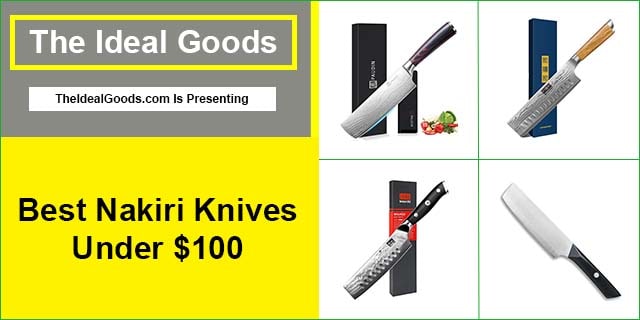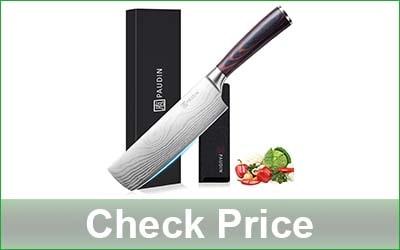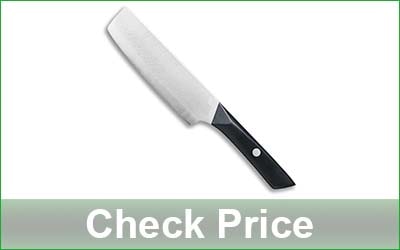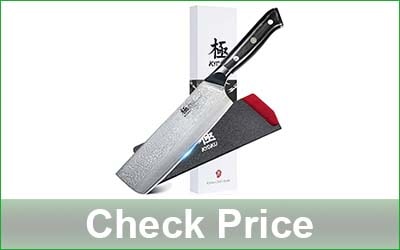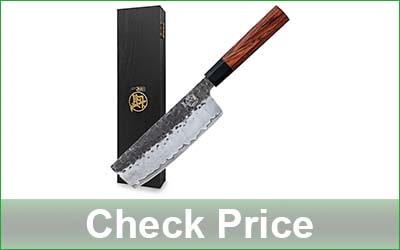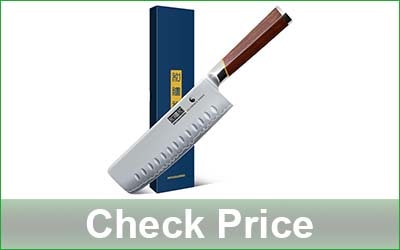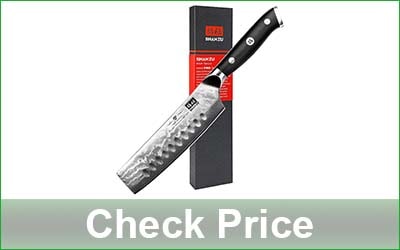To create this list, I initially analyzed over 35 Nakiri knives priced under $100 and personally used and rigorously tested 18 of them for several months. I only recommend the ones that excelled across multiple categories. My reviews are based entirely on firsthand experience, so you can trust that each pick offers solid quality and performance.
Here are the key criteria I used to select the best rated nakiri knives under $100-
- Each knife has earned top ratings from hundreds of satisfied customers.
- Every knife is crafted by a reputable cutlery brand.
- The blade is hand-forged from high-quality steel for outstanding performance.
- It’s versatile, takes a razor-sharp edge quickly, and holds it for a long time.
- Each knife features a full-tang construction for excellent balance and durability.
- The handle is well-sized, easy to maneuver, slip-resistant, and designed to reduce hand fatigue.
- Plus, each knife is backed by a dependable, rock-solid lifetime warranty.
Best Nakiri Knife Under $100 – Comparison Table
Best Nakiri Knife Under $100
1. PAUDIN 7-Inch High Carbon 5Cr15Mov Stainless Steel Nakiri Knife
My Nakiri knife showed up right on time, well packed and protected in a nice, fancy box with a simple sheath. For a Nakiri under $100, it looked sharp, beautifully finished, and came out of the package without any scratches or marks.
Blade: This 7-inch high carbon 5Cr15Mov stainless steel blade has a beautiful wave pattern that almost looks like a Damascus Nakiri Knife. It’s not real Damascus, but the design helps reduce food sticking and cleanup. Straight out of the box, the edge came razor sharp and stayed that way longer than I expected.
I’ve been testing it for months on big cuts like Boston butts, slices right through without tearing the meat fibers. I’ve cut whole chickens too, though I avoid bones since the blade isn’t meant for that. Watermelons were easy to tackle; I could slice the rind so close I barely lost any fruit. Another regular job for this knife is cubing chicken breasts for my dog’s meals. It cuts smoothly, no shredding, just clean cubes every time.
For veggies, this thing’s a dream. Onions, carrots, garlic, peppers – the flat blade makes dicing easy. I love that I can smash garlic with the side too. Small jobs like trimming asparagus tips or slicing tomatoes thin feel almost effortless. I had to adjust my cutting technique a bit since it’s not a rocking blade – straight up-and-down is best, but once I got that down, it made prep faster and more fun. Also, the flat blade makes it easy to scoop and transfer food from the board to the pan.
After steady use for a few months, it still holds a decent edge with just light honing. When it’s time to touch it up, I’ve found a medium grit whetstone works well for this steel and keeps it razor sharp.
Handle: The attractive pakkawood handle feels smooth. It’s fully integrated with the blade, bolster, and end cap, so it feels sturdy. The craftsmanship is clean with no rough spots or gaps where food could get stuck. It’s a full tang design, and the balance between the handle and blade is good enough that my wrists don’t tire out during long prep, but it still feels substantial.
Its larger size fits my hand perfectly, and my spouse’s smaller hands too. The slightly tapered shape feels natural and stays secure, though I added a light oil finish since the wood felt a bit dry. Now it grips comfortably and is a joy to hold, whether my hands are wet or dry. The handle shape works well for both left- and right-handed use.
Sheath: Mine came with a slim sheath that protects the blade in my drawer and a gift box that makes it feel special. I like the extra peace of mind.
Maintenance: I always wash this knife by hand and dry it right away, never in the dishwasher. A quick rinse and wipe keeps it looking good, and I’ve had no rust spots.
Pros
- Beautiful wave blade pattern
- Clean cuts through meat and veggies
- Reduces food sticking when chopping
- Doubles as a scraper when prepping
- Holds edge after months of use
- Easy to maintain and clean
- Comfortable pakkawood grip stays secure
- Lightweight but well-balanced feel
- Fits nicely in larger hand sizes
- Comes with a handy protective sheath
- Lifetime warranty & money-back guarantee
- Top-notch knives at a low price
Cons
- Not for chopping chicken bones
- Handle needed extra oil finish
- Sheath feels a bit too thin
- Smooth handle may slip when greasy
2. MILK STREET 6.75-Inch German High Carbon 1.4116 Stainless Steel Nakiri Knife
My knife arrived earlier than expected in a sleek black-and-white cardboard box, completely undamaged. The packaging was classy enough to gift, though I wish the included cardboard blade sleeve was sturdier. The knife looked sharp and clean, with no flaws.
Blade: The blade is 6.75 inches long and made from 1.4116 high-carbon German steel. It came razor-sharp right out of the box, honed at a narrow 15-17° angle. The surface has a textured, file-like pattern that really helps reduce food sticking.
Over the past few months, I’ve chopped butternut squash, sliced tomatoes, prepped onions, and halved thick cucumbers. The blade moved through each one without crushing or resistance, even the dense squash. The flat edge made push-cuts fast and controlled.
For lighter prep, I tested it on celery, herbs, and strawberries. The blade handled them all smoothly. I loved how the wide, thin profile let me scoop up chopped ingredients easily, especially helpful with herbs.
The slight curve in the blade does let you rock a little, but it takes away some of the clean chopping power you’d expect in a traditional vegetable cleaver. Still, the textured blade really shines when dealing with sticky, starchy items like zucchini and potatoes.
After about four months of regular use, the edge still slices cleanly through soft-skinned veggies. For this steel, I’d recommend a fine-grit whetstone (1000-3000 grit) to keep it tuned up.
Handle: The handle is made from grey ABS polymer and has a lock-in ergonomic design. It’s a full tang build, which gives it a nice balanced feel overall. While lightweight, the knife doesn’t feel flimsy.
In my hands, the handle was comfortable for quick prep sessions. However, it does feel a bit plasticky and slightly slick when wet. I also noticed a tiny bit of casting residue where the plastic meets the blade, not a dealbreaker, just a small annoyance.
Still, the shape made it easy to guide my grip, and it stayed secure while chopping. It’s clearly designed with simplicity in mind, comfortable for any hand size, and handles everyday kitchen tasks with ease.
Maintenance: I always hand wash this knife and dry it right away. It’s not dishwasher safe, and I wouldn’t risk the edge or handle by tossing it in with other utensils.
Pros
- Sharp edge for slicing soft veggies
- The blade seems to hold up well
- File-textured blade reduces food sticking
- Great size for everyday veggie prep
- Wide blade scoops chopped food easily
- Handle is full tang and feels solid
- Ergonomic grip fits hand comfortably
- Lightweight and easy to handle
- Excellent value for the price
- Easy to clean and maintain
- Top rated Nakiri knife under $100
Cons
- Handle feels a little cheap
- Not ideal for wet or greasy hands
- Slight curve reduces chopping power
- Balance could be slightly better
3. KYOKU 7-Inch Japanese VG-10 Core with 67-Layer Stainless Steel Damascus Nakiri Knife
My Nakiri arrived a day earlier than I expected, which was a nice surprise. It came in beautifully giftable packaging that truly looked artful and thoughtfully designed. When I first held it, I was impressed by how flawless the knife was, not a single mark, and the Damascus pattern was absolutely stunning. The weight of the knife also caught me off guard in a good way.
Blade: The blade on this Nakiri is made from a 7-inch Japanese VG10 steel core wrapped in 67 layers of Damascus steel. Right out of the box, it felt wickedly sharp, and that edge really showed its worth after weeks of daily chopping.
I’ve mainly used it for tackling big, dense veggies. It slices through thick raw carrots and chunky potatoes like a warm knife through butter – no launching bits across the counter. On leafy greens, it gives super clean cuts without bruising them. I’ve also used it on cuts of beef, fish, trimming fatty sections for my curry, and even splitting chicken wings for my barbecue nights.
For smaller stuff, I tested it on tomatoes, squash, kumquats, kiwis, and even strawberries. The thin edge slices tomato skins so cleanly, and I can shave them paper-thin if I want. With fruits like oranges, lemons, and bananas, it cuts through the peel without smashing the insides. Every slice feels controlled and smooth.
After steady daily use for weeks, the edge still slices neatly. I keep it touched up with my 1000/6000 grit stone, which works great for the VG10 steel.
Handle: The handle is made from tough G10 material and has full-tang construction that runs the whole length for balance. It has a nice heft, but the balance feels centered right near the pinch point, so it doesn’t feel tiring during longer prep sessions.
I love the mosaic pin accent, the bolster, and the end-cap; the craftsmanship feels so smooth and solid in hand, with no rough edges or gaps. It’s smooth without being slippery, and the size fits my grip perfectly, staying secure even when my hands get damp. There’s even a thick metal end cap, handy for cracking garlic or nuts if needed.
Sheath: The hard plastic sheath with a velvety inside keeps the blade safe and my fingers safer when I’m digging around the drawer.
Maintenance: I wash this under $100 dollars Nakiri knife by hand with a little water and dry it right away. I never stick it in the dishwasher, and that’s kept it looking and cutting like new.
Pros
- Best nakiri vegetable knife under $100
- Real Damascus pattern looks like art
- Japanese VG10 steel holds sharp edge long
- Love the heft for tougher chopping jobs
- Cuts dense veggies and raw meats easily
- Paper-thin slices, soft items never get smashed
- Full-tang handle feels balanced and solid
- G10 handle stays grippy with damp hands
- Comfortable and ergonomic with no wrist strain
- Sheath protects blade safely inside drawer
- Easy to keep clean with a quick wash
- Lifetime aftersales warranty gives real peace
- High-quality Nakiri that won’t break the bank
Cons
- A bit heavier than my other Nakiris
- Can feel too wide for tiny tasks
- Sheath could be more durable
4. MITSUMOTO SAKARI 7-Inch 3-Layer Japanese 9CR18MOV High Carbon Stainless Steel Nakiri Chef Knife
My knife arrived a bit earlier than I expected, packed safely inside a nice wooden box. The box includes blade oil to help prevent corrosion, which was a really thoughtful addition. Opening it felt like unwrapping a special gift.
Blade: The blade is a 7-inch hand-forged piece made from three layers of Japanese 9CR18MOV high carbon stainless steel. Right out of the box, it was sharp enough to shave paper edges. The edge profile works well for both push and rock cutting.
Over the past couple of months, I’ve mostly used it for tougher vegetables like chopping dense carrots, dicing chunky potatoes, and cutting spaghetti squash. It slices through them like butter, and I get each task done quickly with almost no effort. Slicing raw salmon, thick boneless meat, or chicken breast, this knife makes clean, smooth cuts without tearing or shredding. For smaller items, I’ve minced plenty of garlic and onions, and that slightly straight belly helps with forward push cuts and quick mincing.
I also like the Tsuchime hammered finish, it doesn’t stop food from sticking completely, but it does better than my plain knives. The blade’s stainless content really helps with cleaning and rust prevention. It’s not the Japanese highest-end steel, but for daily veggie prep, the sharpness and edge geometry make a real difference.
The edge has stayed sharp enough for a few weeks of daily use without needing major work. I’ve found a ceramic water stone works best for touching up this steel. I keep it honed with a ceramic rod and touch it up on a leather strop every so often.
Handle: The handle is made from rosewood, shaped in an octagonal design that feels secure in my grip. It’s a full tang, and the balance is slightly blade-forward, which I actually like when chopping veggies. It’s got some weight but doesn’t feel heavy in a tiring way.
The size is sturdy enough for my hands and has a nice smooth finish, though the sharp edges on the handle could be more rounded. Overall, it sits comfortably, giving me good control when I’m working through a pile of prep.
Maintenance: I always hand wash it right after use and dry it completely with a towel. I never toss it in the dishwasher. I wipe on a bit of oil before storing it, which keeps the blade from rusting.
Pros
- Cuts carrots, onions & meats like soft butter
- Stays sharp enough for weeks straight
- Tsuchime finish helps reduce food sticking
- Full tang build feels strong and sturdy
- Handle feels comfortable and well-sized
- Good balance makes long prep work easy
- Wooden box looks nice for gifting too
- Comes with knife oil for maintenance
- Excellent capable knife, worth the price
- Warranty support gives extra peace
- Best Nakiri chef knife under $100
Cons
- Needs extra care due to Japanese steel & wood
- Handle edges feel sharper than expected
5. HOSHANHO 7-Inch Japanese 10Cr15CoMoV Core 5-Layer Composite Steel Nakiri Knife
My knife arrived a day early, beautifully packaged in a velvet-lined gift box. Right away, it felt well-balanced and looked impressive. The layered steel and visible core show solid forged construction, definitely a quality piece without the high price tag.
Blade: The 7-inch blade is crafted from 5-layer composite steel, with a 10Cr15CoMoV Japanese core that’s hardened to 60-62 HRC. Out of the box, it was razor-sharp and handled everything I threw at it.
I started with large items like sweet potatoes, cabbage, squash, and watermelon – no resistance at all, just smooth, clean cuts that made cutting a breeze. On other days, it powered through carrots and butternut squash like they were soft fruit. For slicing frozen strawberries, the weight and balance gave me clean, controlled cuts without smashing them. I also tested it on thick cuts of boneless meat, fish, chicken, and chuck roast; the knife sliced cleanly with almost no effort.
For lighter prep, I’ve used this high-quality Nakiri knife under $100 to slice juicy tomatoes, green onions, and bell peppers with zero resistance. It also made peeling garlic super easy, just a gentle smash and the cloves popped right out. Even paper-thin lemon slices felt effortless. The flat blade shape made it ideal for downward cuts, and the 15° double-bevel edge stayed true across all my test items. I can assure you that, after a few weeks, it will completely replace your older vegetable knife for daily use.
After several weeks of heavy testing, the edge still performs well. I touched it up using a diamond bench hone and a strop. For a full sharpening, I’d recommend a 1000/6000 grit whetstone for this steel.
Handle: The red sandalwood handle is one of the highlights of this knife and is seamlessly attached with no visible gaps. It has a deep, rich grain that looks beautiful and feels solid in the hand. The end is capped, and while the tang isn’t exposed, it feels like a full tang. The slightly weighted handle provides natural balance, with the center just forward of the bolster.
I really like the hexagonal shape; it keeps my grip steady and prevents the knife from twisting mid-cut. It’s thick enough to fit comfortably in my hand, giving me full control whether I’m chopping or working quickly. Compared to slimmer handles I’ve used in the past, this one causes noticeably less hand fatigue during longer prep sessions. Even with wet hands, it remains grippy and secure without slipping.
Maintenance: I hand wash this knife with warm, soapy water and dry it immediately. It’s definitely not dishwasher safe, and I avoid soaking to keep the blade finish intact.
Pros
- Agile multipurpose knife for everyday use
- Slices through meat and veggies easily
- Blade recesses reduce food sticking
- Wide blade helps with scoop transfer
- Great for heavier prep tasks too
- Red sandalwood handle is stunning
- Feels balanced and well-crafted
- Full tang and forged construction
- Elegantly packaged in a premium gift box
- Comes with a limited warranty
- High quality Nakiri, but not a wallet breaker
Cons
- A bit heavier than most nakiris
- Handle may feel large for small hands
- Needs careful hand washing
- Not dishwasher safe at all
6. SHAN ZU 7-Inch 10Cr15MoV Core with 67-Layer Damascus Stainless Steel Nakiri Knife
My knife arrived a bit earlier than I expected, tucked neatly in a sleek black gift box with a plastic sleeve and tip cap for extra protection. The swirl and raindrop patterns on the blade looked stunning straight out of the package.
Blade: The 7-inch blade is made from 67 layers of Japanese high-carbon super steel, with a 10Cr15MoV core that feels seriously tough. Right away, I noticed how insanely sharp it was; I didn’t have to force anything.
I’ve had this Nakiri knife under $100 in use for two months now, and for bigger jobs, I’ve tackled sweet potatoes, butternut squash, and thick cabbages. The blade glided through without sticking, thanks to the hollow grind grooves. Cutting dense squash used to feel like arm wrestling, but with this knife, the weight of the blade did most of the work. I’ve also sliced through loads of carrots and raw beets without having to push hard, and every cut has stayed straight and even.
For smaller stuff, I use it almost daily for onions, mushrooms, herbs, and fruits like apples. No tearing or veering off to the side, just clean slices every time. This one doesn’t just handle chunky veggies and delicate herbs; I’ve also used it on poultry, thick cuts of meat, fish, and steak without ever needing to switch knives, and it’s never let me down.
I can tell you this versatile nakiri will quickly become your go-to for prep because it always feels like it’s working with me, not against me. After months of daily veggie prep, the edge still bites cleanly. I plan to touch it up soon with my whetstone; a 1000/6000 grit works great for this steel.
Handle: The handle is G10 glass fiber and triple-riveted, with a full tang that keeps the weight nicely balanced between blade and handle. The craftsmanship feels solid; the handle, rivets, bolster, end-cap and tang line up perfectly with no gaps or rough edges. It’s not too thick or too slim, not front-heavy or too light – just right for my hand.
The slight curve sits well in my palm. Even when my hands get wet or sweaty, the handle’s texture helps my grip stay secure and slip-free. I’ve spent long prepping sessions chopping veggies, and my hand never feels worn out.
Maintenance: I always wash it by hand right after use and dry it thoroughly. Definitely never putting it in the dishwasher, I want this edge to last.
Pros
- Real Damascus layers, not just etched
- Precisely cuts soft veggies, fish & meats
- Glides through thick veggies easily
- Hollow grind keeps food from sticking
- Full tang gives a solid, balanced feel
- G10 handle stays comfy even when wet
- Well-balanced for long food prep sessions
- Build quality feels sturdy and reliable
- Comes with 12-month warranty coverage
- Great value, definitely worth the price
Cons
- Not safe for dishwasher cleaning
- Pattern design could look more detailed
- Print on the handle looks pixelated
- There is no lifetime warranty
Frequently Asked Questions About the Best Nakiri Knife Under $100 (FAQ)
Question: What should I look for when buying a Nakiri knife under $100?
Answer: Look for high-carbon stainless steel, a comfortable, well-sized slip-resistant handle, full-tang construction, and good balance. Read real user reviews to confirm edge retention, sharpness, and durability. Trusted brands with lifetime warranty often deliver better performance for this price.
Question: Are Japanese-made Nakiri knives better than others in this price range?
Answer: Japanese-made Nakiri knives are often better crafted, using traditional forging and harder steels for sharper edges. However, some Western brands offer excellent quality too. Focus on steel quality, construction, and balance instead of origin alone.
Question: What steel is best for a Nakiri knife under $100?
Answer: High-carbon stainless steel like VG10, AUS-8, 5Cr15Mov, 10Cr15CoMoV, Damascus or German steel is ideal under $100. These steels balance sharpness, edge retention, and corrosion resistance well. Look for heat-treated or forged blades for reliable performance and easy maintenance.
Question: What is a Nakiri knife under $100 used for?
Answer: A Nakiri knife under $100 is designed for precise vegetable prep – chopping, slicing, and dicing. It’s also useful for preparing fish, chicken, and boneless meat. Its flat blade and straight edge make clean cuts through veggies, herbs, and fruits without rocking, providing consistent, thin slices every time.
Question: How do you sharpen a Nakiri knife under $100?
Answer: Use a 1000/6000 grit whetstone for the best edge. Start with a coarse grit to reset the bevel, then refine with finer stones. Maintain a consistent angle, around 15 degrees, and finish with honing for extra sharpness.
Question: How do you care for a Nakiri knife under $100?
Answer: Hand wash the blade immediately after use with mild soap. Dry completely to prevent rust. Store in a knife block or sheath. Hone regularly, sharpen when dull, and never cut bones or frozen foods to extend lifespan.
Question: What should you not cut with a Nakiri knife under $100?
Answer: Avoid cutting bones, frozen foods, or extremely hard items. A Nakiri is best for vegetables and herbs; using it on tough materials can chip or dull the blade quickly.
Question: What kind of handle is best for a Nakiri knife around $100?
Answer: Look for an ergonomic, slip-resistant handle made from durable materials like pakkawood, stabilized wood, or composite resin. A full-tang design improves balance and control, while a comfortable grip helps prevent hand fatigue during longer chopping sessions.
Question: How long does a Nakiri knife under $100 last?
Answer: With proper care, a good Nakiri knife under $100 can last five to ten years or longer. Regular honing, careful hand washing, correct storage, and occasional sharpening will help maintain its sharpness and structural integrity over time.
